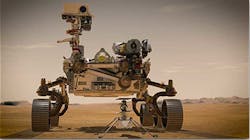For Perseverance’s Mars Mission, Motors are Critical
Perseverance, the fifth NASA rover to explore Mars, is currently roaming the area near its landing site in the Jezero Crater on Mars and using its drone helicopter to get a better view of the surroundings. Like many of the earlier rovers, it is looking for water and signs of past life, or at least signs of the right environmental conditions for it in the past. It is also collecting soil and rock samples with the goal of placing 30 of them in containers that will be picked up and returned to Earth on a future NASA mission to Mars.
Key assemblies on the rover rely on 17 motors from maxon precision motors, inc. to carry out their parts of the mission. For example, they are used to move the robotic arm that transfers geological samples from one station to the next on the rover. Some motors will be used later to seal the sample containers and place them on the surface of Mars, while the drone also depends on six maxon motors to steer.
NASA engineers chose maxon motors based on their experience using over 100 other motors from the Swiss firm on earlier rovers. The specialists at NASA’s Jet Propulsion Lab (JPL) worked with maxon designers to modify and extensively test motors right out of the company’s standard catalog.
Most of the modifications revolve around the environmental conditions the motors will be exposed to on its launch and 290-million-mile trip through space, as well as its two-year mission on the inhospitable surface of Mars. Some of those conditions include:
- Shock and vibration from the rocket launch, as well as atmospheric entry, descent and landing on Mars.
- Vacuum during trip to Mars and the Martian atmosphere once it lands.
- Radiation during trip and once on Mars.
- Temperatures that vary between −184°F and 68°F (−120° to 20°C) daily.
“Based on all of the requirements, we changed the motor and gearbox designs, says Robin Phillips, a maxon engineer who worked closely with JPL. “We made material changes, going from industry standards aluminum or brass for a component to stainless steel or titanium for the Mars motors. This let engineers match expansion coefficients for the different components.
“We also modified how we fix parts together, going from adhesives—the standard—to welding,” Phillips adds. “We also added a few new parts, such as securing rings to strengthen the connections.”
To ensure the rover’s design and components would withstand mission conditions, maxon simulated those conditions and subjected its new motors to them. “To test for resistance to vacuum, we put the motors in a vacuum chamber filled with 8 mbar of CO2 (about 1% of Earth standard pressure) rather than setting a full vacuum,” says Phillips. “We then applied varying loads and ran the motors through required performance profiles.
"We also used ‘shakers’ and shock generators to simulate the vibrations and shock loads of launch, and low temperature chambers to test the motors’ ability to handle the daily temperature changes between night and day.” he adds.
The temperature simulations were important for the drone motors because they are mounted outside the housing, which is kept warm by the batteries to keep the electronics functioning. The motors, however, will feel the full brunt of the frigid nights.
“All of that gave us confidence that if we build the drone’s motors exactly the same way as the motors that survived the qualification tests, then they would work,” Phillips explains. “As they say in the space industry, ‘test what you fly and fly what you test.’”
New testing facilities maxon has invested in over the past 10 years of working with NASA on its Martian programs have also found use in commercial applications. The shock and vibration test rigs, for example, are used to test and improve aviation and automotive products. And the vacuum chambers were critical for developing new welding techniques for titanium.
Unlike steel, titanium needs to be welded without the presence of oxygen. maxon uses titanium in space applications for its strength and low mass. The company also uses it in medical applications such as implantable motors because it is inert, which makes it biocompatible. The first example time maxon “borrowed” its titanium welding equipment from the space programs was to develop a motor that helps maintain cardiac patients’ blood flow.
Space applications constitute a small portion of maxon’s orders, but the tough requirements push the firm to perform. This is evident in the increased quality standards—as well as new testing methods—which also benefit customers in other areas, such as medical technology. “Apart from this, such space missions are simply incredibly fascinating,” says Eugen Elmiger, CEO of the maxon Group. “Time and time again, I feel honored and proud that our drives are used in these technically groundbreaking Mars missions.”



